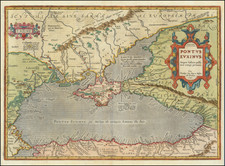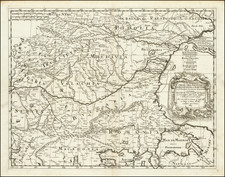Interesting Ukrainian-language post-World War II map of Lviv, Ukraine.
The map is focused on firefighting, with the upper-left corner including an image and slogan entreating people to join the volunteer fire brigade. In the upper-right corner is a firefighter telling the reader "Remember! Fires are easier to prevent than extinguish."
Lviv is one of the major Ukrainian cities originating from the mid-1200s. From 1262 – it was the capital of Kingdom Galicia-Volhynia, from 1775 to 1918 – the capital of the Kingdom of Galicia and Lodomeria, from 1919 to 1939 it was a Polish city. The old town of Lviv is regarded a UNESCO heritage site. Through ages, Jews and Poles were the most influential ethnic groups of the city. This all changed during the mid-XXth century.
World War II spared the city architecture: unlike Minsk or Gdansk, the city was almost untouched by the artillery and air bombings. But the war did not spare the Jewish citizens. In the 1930s Lviv housed 312,231 citizens with 50% of them Polish, 32% Jewish, and only 15% Ukrainians. In June 1941 the Lviv ghetto was established: it was the third large ghetto after Lodz and Warshaw. Over 100,000 people of Jewish origin were prisoners, tens of thousands were killed by Nazis. The synagogues were burned down. When the Soviet Army took Lviv, only mere hundreds of Lviv Jews survived in the city, some hiding in the sewers.
After the Second World War, the city also lost the majority of its Polish citizens: as Lviv became the part of the Soviet Union within the Ukrainian State Soviet Republic, Poles were moved to Ziemie Odzyskane in Poland and by 1950 the city was mostly Russian and Ukrainian: there were only ca. 30,000 poles and ca. 19,000 people of Jewish origin. Nowadays, according to the 2001 census, Lviv houses over 750,000 citizens with only 1,900 Jews and 6,400 Poles.
The map looks cheaply made. This is no wonder given the economic realities of the first post-WWII years in the USSR with the lack of resources, lack of human capital, and destroyed infrastructure. It shows the city gaining the momentum of rapid manufacturing development and an exotic mix of ancient, Soviet, and Polish toponyms: one can see Chapayev and Gorky streets near Kostyushko, Mickiewicz, and Khmelnitsky streets – all in one city.
The plan is an important piece of information on Lviv city during the late 1930s-1960s. It is mentioned in the 2012 publication Cartographic Leopolitana postwar period 1944-2012 by O. V. Shyshka, head of Scientific Library Lviv Polytechnic National University. The researcher states that all Soviet maps under 1:100,000 were “secret” and mostly for military use, so all detailed Lviv maps from 1939 were also “secret“ - the next city plan available for the public appeared only in 1967. This map, although printed already under Soviet censorship, is made using the 1:10,000 scale (with some deformations and changes in the plan). It’s not known why it was allowed for printing.











![[ Postal Map of Eastern Europe ] Deutschlands Postkarte begraenzt von Oesterrreich, Preussen, Frankreich, Holland, Italien und der Schweiz. Gezeichnet und Herausgegeben von Ignaz Heymann. K.K. Obserpostamtsoffizier in Trieste. 1800.](https://storage.googleapis.com/raremaps/img/small/77678.jpg)


![[ Odessa ] Генеральный Планъ Города Одессы съ Принадлежащею Оному Землею Раздѣленною на 6ть Частей съ показанiемъ Предмѣстiй, селенiй, хуторовъ, садовъ и другихъ Казенныхъ и частныхъ заведенiй. [General Plan of the City of Odessa...]](https://storage.googleapis.com/raremaps/img/small/56509.jpg)
![Russian Empire [with] Chart of the Communication Between The Archipelago And Black Sea](https://storage.googleapis.com/raremaps/img/small/64013.jpg)
![[Poland, Croatia, Slovenia, Hungary, Serbia, Romania, Ukraine, Bulgaria] (La discrittione della Transylvania et parte del l'Ungaria, et il simil della Romania)](https://storage.googleapis.com/raremaps/img/small/59225.jpg)